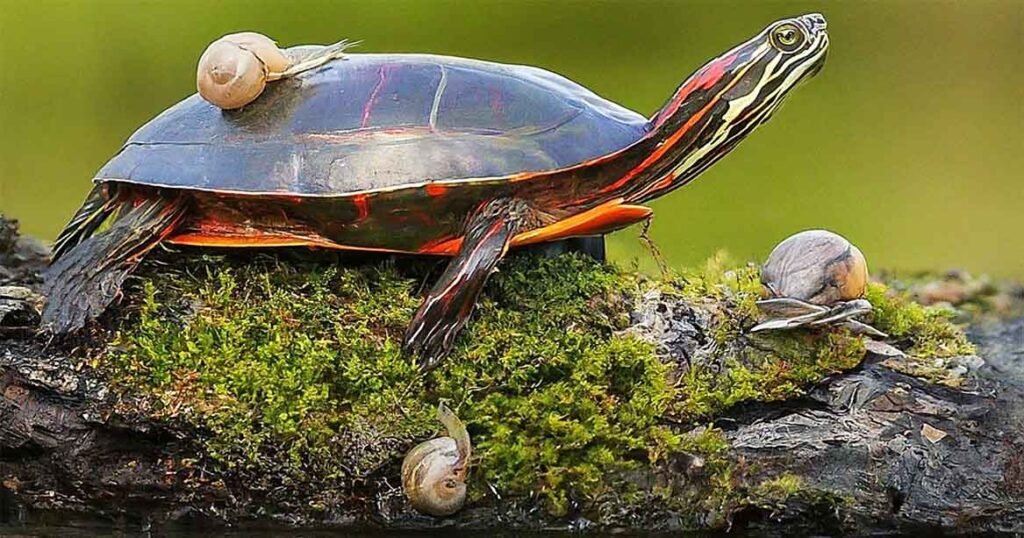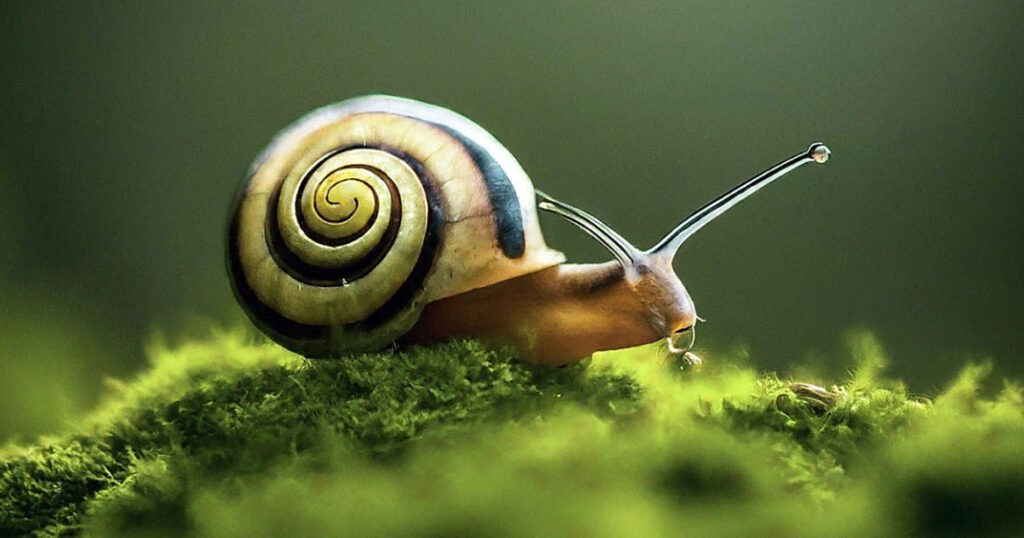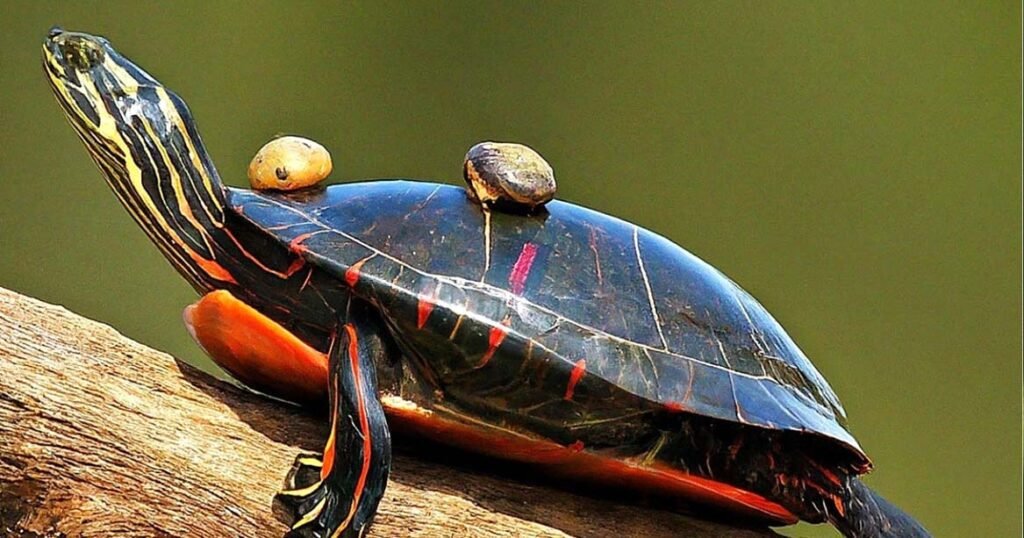Snails are small, slow-moving mollusks with spiral shells. Snails can be found both in deep ocean trenches and in deserts. Did you ever witness a turtle curiously watching a snail? Have you ever wondered if these slow-moving neighbors should be on the turtle’s menu? So, do turtles eat snails? The truth is, it depends on the turtle and the snail.
While some turtles are natural-born snail snackers, others prefer a plant-based diet. In this article, we’ll explore the relationship between turtles and snails and the question: do turtles eat snails? Additionally, we’ll talk about the benefits and risks of feeding snails to turtles.
Do Turtles Eat Snails?

Yes, turtles can consume snails. In the wild, aquatic turtles catch snails from their surroundings and eat them. Turtles’ snail diet preference depends on the species’ variation. Some turtle species prefer to savor snails, like omnivores or carnivore turtles.
Snails are a great source of nutrition, as are protein and calcium, which are necessary for turtles’ bone and shell development and health. Not all snails are safe for turtles, especially the parasite or bacteria-infected ones.
Which Types of Snails Do Turtles Eat?

When they’re in the wild, turtles might eat everything they can get their hands on. Turtles can have almost all types of snails they get in their natural habitat. But things are a bit different for pet turtles.
For our shelled friends at home, it’s essential to stick to specific types of snails that are safe and parasite-free. These can include:
- Apple snails
- Bladder snails
- Ramshorn snails
- Pond snails
- Nerite Snails
- Mystery Snails
There are many snail types that turtles can eat depending on your turtle’s size and dietary needs. Always remember, a healthy pet turtle starts with a nutritious diet, so make sure those yummy snail snacks are coming from a reliable source.
Nutritional Table for Snails (Per 100g Serving)
Here’s a table showing snail nutritional content:
| Nutrient | Amount |
| Protein | 16.1 g |
| Calcium | 10 mg |
| Iron | 3.5 mg |
| Potassium | 382 mg |
| Vitamin A | 30 mcg |
| Total Carbohydrate | 2 g |
| Calories | 90kcal |
| Total Fat | 1.4 g |
| Saturated Fat | 0.361 g |
| Cholesterol | 50 mg |
| Sodium | 70 mg |
Health Benefits Of Eating Snails For Turtles

While snails might not be the most glamorous meal for us, they can be a surprising source of nutrients for turtles. Here’s a closer look at some key ingredients in snails and how they can benefit your shelled friend:
Protein Power
You can think of protein as the building blocks of your turtle’s body. It helps them grow strong muscles and repair tissues, keeping them healthy and active. Snails are packed with protein, just like tiny protein treats for turtles.
Calcium Champion
Strong bones and a sturdy shell are essential for a healthy turtle. Calcium helps with both, and snails can boost your turtle’s diet.
Iron Essential
Iron might seem tiny, but it’s crucial for proper blood cell production in turtles. These blood cells carry oxygen throughout the body, which keeps your turtle energized.
Potassium
Potassium helps muscles function properly, and nerves transmit signals throughout your turtle’s body. Snails are bursting with potassium, which is like an electrolyte drink for your tiny tank-dweller.
However, the calcium and potassium ratio is not correct in snails, so you have to be moderate while serving snails to your pet.
Vitamin A
Vitamin A is essential for turtles’ healthy vision and skin and for a strong immune system. Snails contain a small dose of this vital vitamin, but with a balanced meal plan, it can contribute to your turtle’s overall well-being.
Remember: While snails can be a nutritious treat, they shouldn’t be the only food source for your turtle. A balanced diet is vital to a happy and healthy shelled friend.
Live Vs. Canned: Which is the Safest Option for Turtles?
Choosing between live and canned snails for your turtle’s diet can be confusing. Live snails might seem like a more natural option, but they have some hidden dangers.
Wild snails can carry parasites that can make your turtle sick. One of the biggest problems with wild snails is Goniobasis Tenera Lung Fluke. Studies have documented how these parasites can infect and kill loggerhead turtles.
Even if you buy live snails from a pet store, there’s always a chance they are infected. Canned snails, on the other hand, have likely undergone processing to minimize these risks.
However, canned snails have their drawbacks. They might not be as nutritionally rich as fresh snails since the processing can affect some nutrients. Also, be sure to check the ingredients list on canned snails. Some brands might have added preservatives or fillers that aren’t ideal for your turtle’s health.
Ultimately, the best way to decide is to talk to your veterinarian. They can consider your turtle’s specific needs and preferences, such as its species, age, and overall health.
Potential Risks of Frequent Feeding of Snails for Turtles
Turtles can enjoy snails occasionally, but keep these things in mind when adding them to their diet:
Parasite & Bacteria
Wild snails can carry parasites that could make your pet turtle sick. However, in the wild, turtles are used to catching and eating snails by their instinct.
If you want to avoid this risk, get feeder snails raised in a fresh environment or from a commercial farm. Make sure any snails you offer are fresh and come from a reputable source.
Cholesterol and Sodium
Those tiny snail bodies do contain some cholesterol and sodium. Cholesterol is high (50 mg in 100 servings), so too many snails can lead to health problems for your turtle.
50mg of cholesterol per 100g serving might seem low, but for a small turtle, it could be a significant amount. It’s like giving your turtle too much junk food – not good for them in large quantities. So, before setting your turtle’s diet, if you are unsure, consult a vet.
Calcium-Potassium Balance
Calcium is excellent for a turtle’s shell and bones, and snails do offer some calcium. However, the calcium-to-potassium ratio in snails isn’t ideal for a turtle’s long-term health. For your turtle, snails alone might not provide the right combination of ingredients.
Feeding Guide Tips & How Much Should Be Included
Before serving snails to your pet turtle, follow these tips:
- Wash or clean thoroughly. If you need clarification, ask your vet about safe washing methods for snails.
- Get snails from reliable pet stores to avoid parasites.
- Gardens or wild snails might have pesticides, so skip them.
- Offer 2-3 snails every 1-1.5 weeks as a fun snack, not a main course.
FAQs
Do box turtles eat snails?
Yes, box turtles can eat snails. In fact, in the wild, box turtles consume snails from their surroundings. Snails are an excellent protein source for box turtles’ overall diet.
Do aquatic turtles eat snails?
Definitely, aquatic turtles savor snails in the wild. Snails are creatures that are found in wet environments as well as deserts. Aquatic turtles also spend their time in moist atmospheres. So, it is very natural for aquatic turtles to find snails and have them from their natural habitat.
Do baby turtles eat snails?
Baby turtles are primarily carnivores, so they eat snails. However, you should serve snails more cautiously for baby pet turtles, considering their size. Snails can fulfill turtles’ protein needs from a balanced snail diet.
Do freshwater turtles eat snails?
Yes, freshwater turtles can savor snails from their surroundings. It is widespread for them to find snails in the wild, and it is a natural diet for them. Snails are also a healthy option for them.
Read More: Do Turtles Eat Minnows?
Conclusion
Some turtles naturally eat snails, while others prefer leafy greens. Snails can be a fun, occasional treat for some turtles, offering a protein and nutrient boost. But remember, don’t go overboard.
Talk with your veterinarian about the best way to include snails in your turtle’s diet. Also, keep in mind parasite risks and the importance of a balanced menu.
